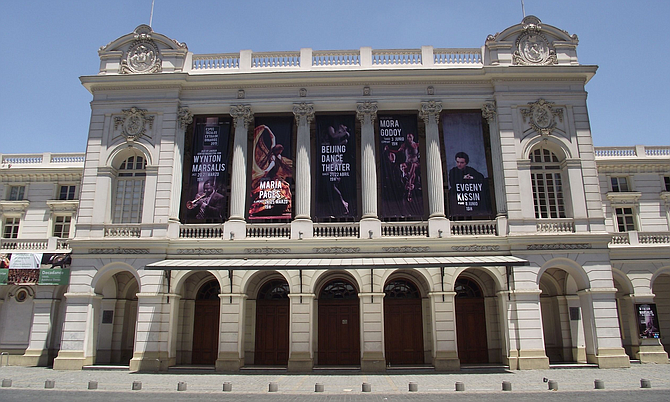 Facebook
Facebook
 X
X
 Instagram
Instagram
 TikTok
TikTok
 Youtube
Youtube

Slipped Disc website is reporting massive employee cuts by the Teatre Municipal de Santiago. The company is the national theater of Chile and is located in the capital of Santiago. The theater was inaugurated in 1857 with a performance of Verdi’s Ernani which was Verdi’s most popular opera at the time, save for the recently completed Il Trovatore.
Over the decades the theater has welcomed all the world-class artists we could expect a national theater to present. However, on Monday, July 22, this statement was issued by the theater: “Santiago – July 22nd, 2019. The Board of Directors of the Municipal de Santiago approved a reorganization plan for the institution in order to face the delicate economic phase it is now undergoing, thus securing its continuity and healthy operations.”
The reorganization plan included the layoff of 59 staff members and the voluntary retirement of an additional 19 staff members. The statement goes on to explain that the reductions will save the theater about $2.2 million per year.
Let’s take a little look at these numbers and then add the inevitable conjecture.
$2.2 million divided by 78 staff members comes out to an average employee cost of about $24,000 per year. However, the number that jumped out to me was that 59 employees represented 13 percent of the entire staff and were primarily administration and technical staff.
59 is 13 percent of 460. Why does a theater need 460 employees?
It depends on what makes up the 460. If the orchestra, chorus, and ballet corps are included then the number grows quickly. The San Diego Opera does a “how many people does it take to make an opera” event at intermission of their student dress rehearsals. The number comes in around 200-250 and includes all the artistic, production, and administrative staff down to the interns.
The San Diego Opera isn’t a national theater but a big chunk of that 200-250 are part-time employees in the chorus and in the wigs/makeup and costuming departments.
The question remains. Why does a theater need 460 employees? Let’s say 300 are full- and part-time artistic and production staff. Does that mean the theater needs 160 administrators?
Obviously the answer is no and that’s why the cuts were made in the administration and technical (production) staff. I think this is the beginning of the culling of the herd of administrators and production staff which large-scale arts institutions harbor.
The unions in the United States are going to have to take a hard look at their collective bargaining agreements versus the continuation of the current paradigm of artistic production which was empowered by the Ford Foundation in 1966.


Slipped Disc website is reporting massive employee cuts by the Teatre Municipal de Santiago. The company is the national theater of Chile and is located in the capital of Santiago. The theater was inaugurated in 1857 with a performance of Verdi’s Ernani which was Verdi’s most popular opera at the time, save for the recently completed Il Trovatore.
Over the decades the theater has welcomed all the world-class artists we could expect a national theater to present. However, on Monday, July 22, this statement was issued by the theater: “Santiago – July 22nd, 2019. The Board of Directors of the Municipal de Santiago approved a reorganization plan for the institution in order to face the delicate economic phase it is now undergoing, thus securing its continuity and healthy operations.”
The reorganization plan included the layoff of 59 staff members and the voluntary retirement of an additional 19 staff members. The statement goes on to explain that the reductions will save the theater about $2.2 million per year.
Let’s take a little look at these numbers and then add the inevitable conjecture.
$2.2 million divided by 78 staff members comes out to an average employee cost of about $24,000 per year. However, the number that jumped out to me was that 59 employees represented 13 percent of the entire staff and were primarily administration and technical staff.
59 is 13 percent of 460. Why does a theater need 460 employees?
It depends on what makes up the 460. If the orchestra, chorus, and ballet corps are included then the number grows quickly. The San Diego Opera does a “how many people does it take to make an opera” event at intermission of their student dress rehearsals. The number comes in around 200-250 and includes all the artistic, production, and administrative staff down to the interns.
The San Diego Opera isn’t a national theater but a big chunk of that 200-250 are part-time employees in the chorus and in the wigs/makeup and costuming departments.
The question remains. Why does a theater need 460 employees? Let’s say 300 are full- and part-time artistic and production staff. Does that mean the theater needs 160 administrators?
Obviously the answer is no and that’s why the cuts were made in the administration and technical (production) staff. I think this is the beginning of the culling of the herd of administrators and production staff which large-scale arts institutions harbor.
The unions in the United States are going to have to take a hard look at their collective bargaining agreements versus the continuation of the current paradigm of artistic production which was empowered by the Ford Foundation in 1966.
Comments